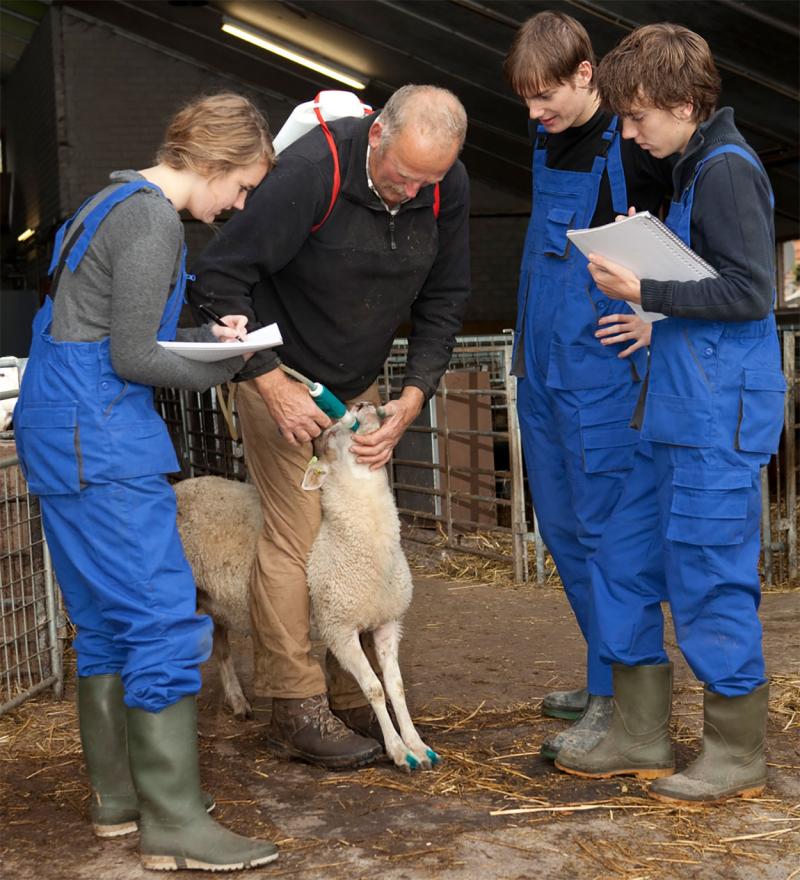Written with contributions by Heidi Carroll, former SDSU Extension Livestock Stewardship Field Specialist & Beef Quality Assurance Coordinator, and Kelly Froehlich, former Assistant Professor & SDSU Extension Sheep and Goat Specialist.
Using an effective dewormer properly can be part of a strategy in preventing internal parasites in sheep and goats. However, improper use or using an ineffective dewormer can exacerbate resistance and production losses due to internal parasite infection. So how do you know if your dewormer is effective, and what does it mean to use it properly?
What Does It Mean To Use Dewormers Properly?

Improper use of a dewormer can reduce efficacy and promote resistance by ineffectively killing internal parasites. Prior to drenching animals, it is a good idea to check the following about your dewormer and equipment.
Dewormer
- Is it expired?
- How was it stored? Did it get left in a truck or barn over winter?
Equipment (drench gun)
- Is it clean?
- Is the drench gun delivering the correct dose consistently?
- Are there any broken pieces or parts, or sharp edges?
- Do any parts (seal) of the drench gun need lubricating to prevent sticking?
- Is it calibrated and set to the calculated dose for the weight and specie of animal?
Expiration dates and proper storage are important. Dewormers can lose effectiveness over time and recommended storage is typically at room temperature, though labels should always be verified and followed. Exposure to extreme cold or hot can reduce product efficacy.
Drench guns should be cleaned after each use, and they can be stored in a Ziploc bag after they dry. Routine maintenance leads to proper function. It is also important that the drench gun delivers the intended dose. Underdosing can exacerbate resistance by leaving parasite populations that are unaffected by the dewormer. These remaining unaffected parasites reproduce and contribute resistant genes to the following generations. This, overtime, leads to more parasites with resistant genes than without. Calculating dosages correctly and administering them accurately can help prevent that problem. When possible, dosages should be calculated based on the weight of the individual animal. If using one calculated dose for the entire herd/flock, this should be based on the heaviest animal. Except for dewormers with the active ingredient levamisole (e.g., Prohibit), dewormers have a moderate level of safety and slightly overdosing will not cause safety concerns. Administrating drench over the tongue into the back of the mouth and ensuring it is swallowed will also help deliver an intended dose. Drench that is spat back out will not deliver an intended dose, and the animal should be re-drenched.
Lastly, sheep and goats have different dosing requirements. Goats have a higher metabolism and therefore a higher dosing requirement. Drenching a goat using a sheep recommended rate will result in underdosed animals and reduced efficacy. Table 1 is a good resource for checking dose requirements on common dewormers for sheep and goats but should not replace information on product labels or instructions from your veterinarian. It is important to note that many dewormers used for goats are extra-label uses requiring a valid veterinarian-client-patient relationship. Only a licensed veterinarian may prescribe the use of these dewormers for use in species, or at dosages, other than indicated on the product label. Some dewormers, like Cydectin, can be found in different formulations (injectable or pour-on) for different species. However, only formulations labeled for sheep should be used in goats or sheep. Furthermore, cattle pour-on should never be used as an oral drench.
Adapted from Dr. Ray M. Kaplan, American Consortium for Small Ruminant Parasite Control (ACSRPC) website.
1 Any use of dewormers not specifically outlined on the product label (species, dosage, etc.) is considered extra label drug use, requiring a valid veterinarian-client-patient relationship. Only a licensed veterinarian may prescribe their use.
2 Safeguard label dose of 0.56 mL/25 pounds is approved for use in goats. Use of the recommended 1.1 mL is considered extra label.
3 Rumatel chart dose is based on Durvet Rumatel product. It is important to read labels as dosage rates vary among products.
Using Oral Drenches Versus Injectable Dewormers

In small ruminants, it is recommended that an oral drench be used versus an injectable dewormer. Injectable dewormers can exacerbate resistance through a combination of being less effective and slower acting. As most parasites of concern are in the stomach and intestine of small ruminants, use of an oral drench is more effective at delivering a direct dose. In goat field studies, efficacy of oral Ivomec was greater than 98.7% in some common parasites, this was decreased by seven to 13% by using an injectable Ivomec. In addition, injectable dewormer is more persistent, lasting longer in lower concentrations in the body. The combination of this persistence and reduced efficacy leaves parasites surviving treatment, contributing resistant genes and building a dewormer-resistant population faster than an oral drench.
An additional disadvantage of injectable dewormers is an increase in withdrawal times. For example, using injectable Cydectin cattle dewormer in goats gives a meat withdrawal time of 120–130 days compared with a 17-day meat withdrawal for Cydectin oral sheep drench.
Is Your Dewormer Effective?
If it is determined your dewormer is being used properly, yet your program appears ineffective, dewormer resistance may be the issue. Parasite resistance has been demonstrated in all types of dewormers. An effective dewormer should reduce fecal egg counts by at least 95%. Fecal egg counts are a way of quantifying worm burdens of a living animal by counting and calculating the number of eggs in one gram of feces. A fecal egg count reduction test can quantify the level of resistance in a herd/flock by analyzing the effectiveness of a dewormer. This is done by calculating the percent decrease in eggs prior and seven to 14 days after deworming an animal.
Sample Collection
When collecting samples for the test:
- Identify 10–15 sheep/goats per animal group. Identified animals should be representative of your flock/herd and should not be just the “wormy looking ones.”
- Collect a small amount of fresh manure prior to deworming and seven to14 days after deworming from each identified individual animal (see Table 2).
- Label and refrigerate samples immediately. Refrigerating samples will help keep eggs from hatching. However, do not freeze, as this will ruin the eggs.
Contact your veterinarian for laboratory information. Fecal egg counts can be performed at the South Dakota Animal Disease Research and Diagnostic Laboratory (ADRDL), as well as other laboratories and some veterinary clinics. Submissions to the ADRDL need to be coordinated through or submitted by a veterinarian.
| Dewormer Class |
|
| Levamisole (Prohibit) |
|
| Benzimidazole (Valbazen, Safeguard) |
|
| Macrocyclic lactones (Ivomec, Cydectin) |
|
*If a combination of drenches is used, collect fecal samples 14 days after.
Concluding Remarks
Correctly using dewormers can help slow the spread of resistant parasites. Knowing the efficacy of your dewormer can help determine the need for an alternative approach on parasite management. If there are any questions or concerns about your parasite management protocols, talk with your local veterinarian or an SDSU Extension expert.
References
- Coles, G.C., F. Jackson, W.E. Pomroy, P.K. Prichard, G. von Sameson-Himmelstjerna, A. Silvestre, M.A. Taylor, and J. Vercruysse. 2006. The detection of anthelmintic resistance in nematodes of veterinary importance. Vet Parasitol. 136:167-185
- Kaplan, R., & P. Scharko. American Consortium for Small Ruminant Parasite Control Dewormer Charts. Accessed April 9, 2021.
- Lespine, A., C. Chartier, H. Hoste, & M. Alvinerie. 2012. Endectocides in goats: Pharmacology, efficacy and use conditions in the context of anthelmintics resistance. Small Ruminant Research. 103:10-17
- Zajac, A.M. 2006. Gastrointestinal Nematodes of Small Ruminants: Life Cycle, Anthelmintics, and Diagnosis. Vet Clin Food Anim. 22:529-541


